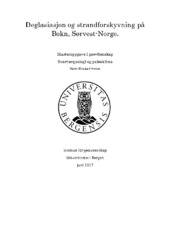| dc.contributor.author | Hernar, Marie Klopstad | |
| dc.date.accessioned | 2017-08-21T07:59:23Z | |
| dc.date.available | 2017-08-21T07:59:23Z | |
| dc.date.issued | 2017-06-29 | |
| dc.date.submitted | 2017-06-28T22:00:03Z | |
| dc.identifier.uri | https://hdl.handle.net/1956/16378 | |
| dc.description.abstract | In this master thesis the late glacial shoreline displacement on Bokn is presented. The data is based on identification of the isolation and ingression contacts in sediment cores from the two isolation basins Gunnarstavatnet (17,4 m a.s.l.) and boknamyr (11,4 m a.s.l.). The determination of the isolation and ingression contacts is done in collaboration with Johnsen (2017) who has performed a phytoplankton analysis. In this thesis, however, analysis of the sediment stratigraphy, geochemical analysis (XRF) and grain size analysis are used to determine the contacts between marine and lakustrine sediments. As the phytoplankton is sampled a few centimeters apart, the possibility of XRF-analysis as a method of more precisely placement of the contacts is considered. The elements used in the analysis are manganese, sulfur, calcium and the ratio of Si/Ti. As well as the shoreline displacement, the deglaciation of Boknafjorden (based on Gump et al., 2017) is presented based on the new 14^C-dates from Bokn along with existing dates in the area (Briner et al., 2014; Gump et al., 2017; Lunnan, 2016; John Inge Svendsen et al., 2015). The chronology of Bokn is based on 14^C-dating of mainly terrestrial plant macrofossils. The results indicate that the exposure ages from Bokn (Gump et al., 2017) may be too old, and thus a deglaciation age up to 2000 years younger than first assumed. This is perhaps due to the deep accumulation of myon-produced 10^Be in the bedrock (Briner et al., 2016). | en_US |
| dc.description.abstract | I denne oppgaven presenteres det senglasiale strandforskyvningsforløpet på Bokn. Kurven er basert på identifisering av isolasjons- og ingresjonskontakter i sedimentkjerner hentet fra isolasjonsbassengene Gunnarstadvatnet (17,4 m o.h.) og Boknamyr (11,7 m .o.h.). Fastsettelsen av isolasjons- og ingresjonskontaktene er gjort i samarbeid med Johnsen (2017), som har utført fytoplanktonanalyse, men i denne oppgaven er det benyttet litostratigrafisk, geokjemisk og kornstørrelsesanalyse. Med tanke på at fytoplanktonprøvene blir tatt med noen centimeters mellomrom, er det gjort en vurdering av XRF som metode i forhold til presisering av isolasjons- og ingresjonskontakter. I undersøkelsene er elementene svovel, mangan, kalsium og forholdet Si/Ti benyttet som indikatorer for endringer i miljø. Det blir også presentert et deglasiasjonsforløp for Boknafjorden (med utgangspunkt i forløpet fra Gump et al. (2017), der de nye 14^C-dateringene på Bokn blir sammenstilt med eksisterende dateringer i området (Briner et al., 2014; Gump et al., 2017; Lunnan, 2016; Svendsen et al., 2015) Kronologien på Bokn er basert på 15 AMS 14^C-dateringer hovedsakelig datert på terrestriske makrofossiler. Resultatene av disse dateringene indikerer at de tidligere eksponeringsdateringene fra Bokn (Gump et al., 2017) kan være for gamle, og at Bokn ble isfritt opptil 2000 år senere enn først antatt. Dette kan i så fall skyldes nedarvet alder fra myoner som produserer 10^Be dypere i berggrunnen/blokkene enn spallasjon fra nøytroner (Briner et al., 2016). | en_US |
| dc.language.iso | nob | eng |
| dc.publisher | The University of Bergen | en_US |
| dc.title | Deglasiasjon og strandforskyvning på Bokn, Sørvest-Norge. | en_US |
| dc.type | Master thesis | |
| dc.date.updated | 2017-06-28T22:00:03Z | |
| dc.rights.holder | Copyright the Author. All rights reserved | en_US |
| dc.description.degree | Masteroppgave i geovitenskap | en_US |
| dc.description.localcode | MAMN-GEOV | |
| dc.description.localcode | GEOV399 | |
| dc.subject.nus | 756199 | eng |
| fs.subjectcode | GEOV399 | |
| fs.unitcode | 12-50-00 | |
